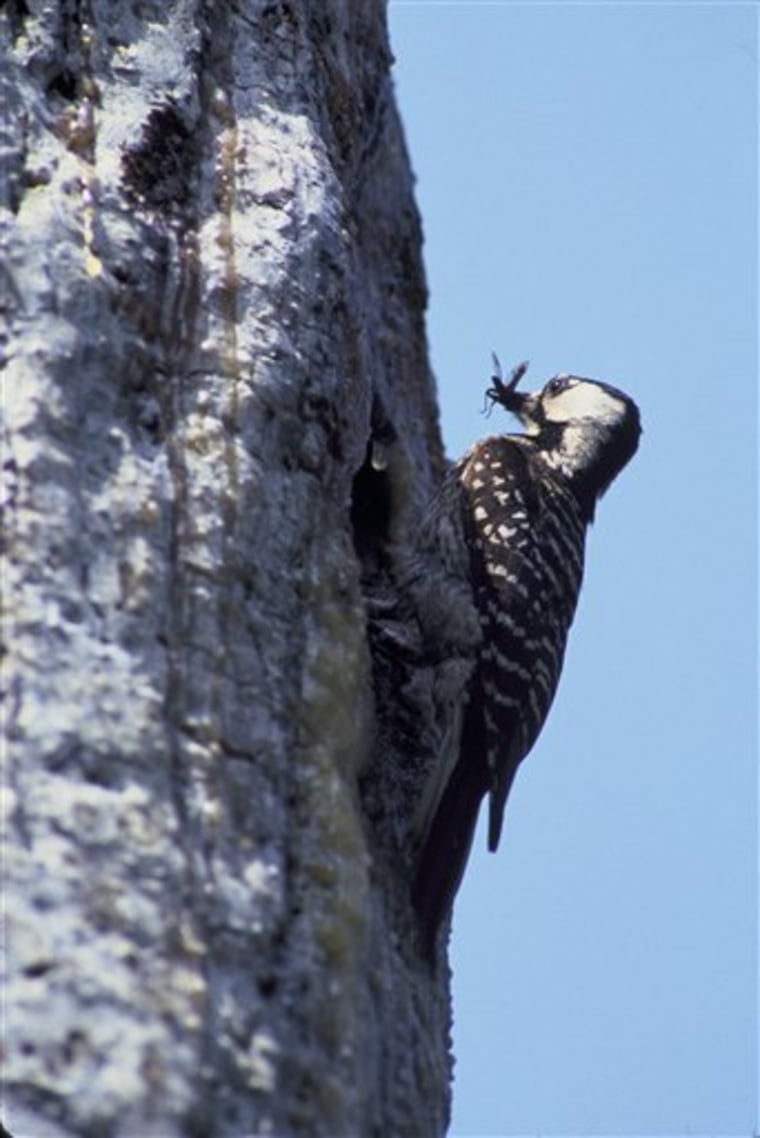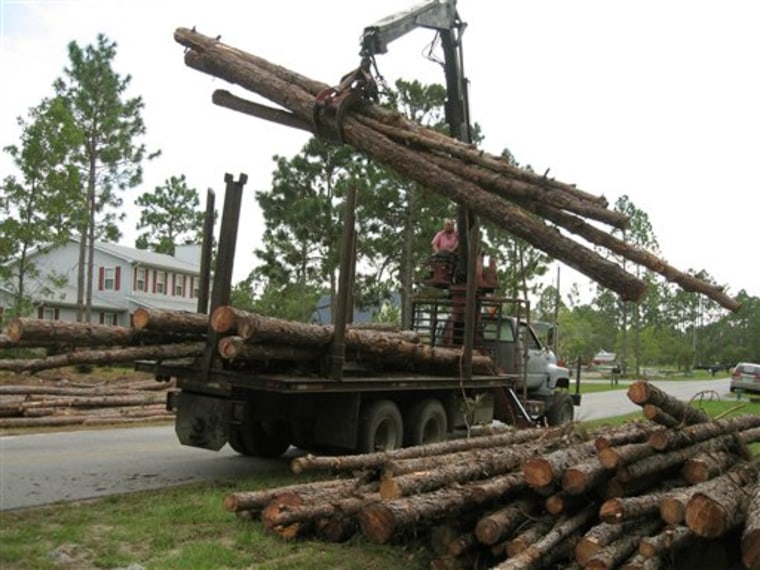What’s black and white and dreaded all over?
In this booming coastal town, it’s the tiny red-cockaded woodpecker.
During the past six months, ugly, stump-riddled gashes have appeared throughout the lush longleaf pine stands here as worried landowners clear cut thousands of trees to prevent them from becoming homes for the endangered bird.
The chain saws started in February when the U.S. Fish and Wildlife Service put Boiling Spring Lakes, a state-designated bird sanctuary, on notice that rapid development threatened to squeeze out the woodpecker.
The agency issued a map marking 15 active woodpecker “clusters” and announced it was working on a new one that could potentially designate whole neighborhoods in the southeastern North Carolina town as protected habitat — and subject to more stringent building restrictions.
Hoping to beat the mapmakers to the printer, landowners swarmed city hall to apply for lot-clearing permits. Treeless land, after all, needn’t be set aside for woodpeckers. Since February, the city has issued 368 logging permits, 90 in May alone, the vast majority without accompanying building permits.
The results can be seen all over town.
Mayor: Beauty ruined
Along the roadsides, scattered brown bark is all that’s left of once majestic pine stands. Mayor Joan Kinney has watched with dismay as waterfront lots across from her home on Big Lake have been gradually stripped down to sandy, denuded wastelands.
“Well, it’s ruined the beauty of our city,” says Kinney.

Since the town’s founding in the early 1960s, the people of Boiling Spring Lakes and the bird with the little red cheek patches lived together in relative harmony. When he built his brick home 14 years ago, retired IBM engineer Bill Davis knew better than to cut down the two sap-streaked pines along the street out front if he didn’t want to risk a fine.
“I don’t have $100,000 I want to give away,” the 71-year-old West Virginia native said with a laugh recently as he stood beneath the tin tag marking one of the trees as a protected nesting pine.
But the honeymoon ended when Fish and Wildlife warned town officials that issuing building permits in certain areas might make them liable for “inadvertent violations of the Endangered Species Act.” Anyone convicted of killing, harming or “harassing” the bird could face up to a year in prison and $100,000 in fines.
The red-cockaded woodpecker — or Picoides borealis — was once abundant in the vast longleaf pine forests that stretched from New Jersey to Florida, but now numbers as few as 15,000.
The RCW is unique among North American woodpeckers because it nests exclusively in living trees. In one of those quirks of history, human activity has made this town of about 4,100 — located in the nation’s 29th fastest-growing county — almost irresistible to the bird.
Humans helped birds move in
Long before there was a town, locals carved V-shaped notches in the pines, collecting the sap in buckets to make turpentine. These “cat face” wounds allowed fungus to infiltrate the tree’s core, making it easier for the woodpecker to excavate its nest hole and probe for the beetles, spiders and wood-boring insects it prefers.
“And, voila! You have a perfect woodpecker habitat,” says Dan Bell, project director for the Nature Conservancy in nearby Wilmington.
The woodpecker gouges a series of holes around the tree, creating “sap runs” to discourage the egg-gobbling black snake, the bird’s chief enemy — besides man. A milky-white coating resembling melted candle wax makes the cavity trees stand out among their unoccupied neighbors.
Because it can take up to six years to excavate a single nest hole, the birds fiercely defend their territory, says biologist Susan Miller in the Fish and Wildlife agency’s Southern Pines office.
“They’re passed from generation to generation, because it’s such a major investment in time to create one cavity.”
Like the woodpeckers, humans also are looking to defend their nest eggs.
Bonner Stiller has been holding onto two wooded, half-acre lakefront lots for 23 years to pay for his kids’ college educations or cushion his retirement. He had both lots stripped of longleaf pines before the government could issue its new map.
“They have finally developed a value,” says Stiller, a state legislator who gave away the trees in exchange for the clearing. “And then to have that taken away from you?”
People have overreacted, says Pete Benjamin, supervisor of the federal agency’s Raleigh office.
Having a woodpecker tree on your property doesn’t necessarily mean you can’t build a house, says Benjamin. A landowner can even get permission to cut down a cavity tree, as long as an alternative habitat can be found.
“For the most part, we’ve found ways to work with most folks,” he says.
But, Stiller asks, who wants to deal with the hassle of going through another layer of bureaucracy? And how many people have the tens of thousands of dollars it can cost to relocate a family of birds?
Some complain the town has been singled out for selective enforcement. But most of the region’s longleaf forests have fallen to agriculture, urban sprawl or plantations of fast-growing commercial loblolly pines, which usually are harvested before they get mature enough to attract the woodpeckers.
“Boiling Spring Lakes, like it or not, has these old flattop longleaf, and no place else seems to,” says Bell, whose group has purchased nearly 7,000 mainly wetland acres around the town since 1999.
Moratorium debated, fails
To stop the rash of cutting, city commissioners proposed a one-year moratorium on lot-clearing permits. When they met Sept. 5, more than 60 people turned out — double the normal contingent.
They were rewarded with their first glimpse of the latest federal bird survey.
The glossy map divided the town into red-outlined woodpecker foraging areas, each containing at least one purple-shaded blob indicating a nesting cluster — 24 in all. Several entire neighborhoods were highlighted. The original map listed 437 lots that might be affected by a cluster; on the revised map, that number rose to 2,704 lots.
Now that the map is out, the city can’t issue a building or tree-clearing permit for any affected property without first running it by Benjamin’s office.
Both of Steve Lowery’s vacant lots were shaded purple. As the meeting convened, a flatbed truck was hauling away the last of the pines Lowery ordered cut from one of the properties.
“I get one lot, and the woodpeckers get the other one,” the construction company supervisor told the commissioners.
Lowery and others argued that since the new map dictated where cutting could occur, the city no longer needed the moratorium. But Commissioner Craig Caster, worried that landowners outside the current woodpecker zones would cut their trees to prevent the bird’s spread, begged for even a two-month halt.
“I feel like the city is getting raped of its trees,” he said.
The measure failed.
Fish and Wildlife is currently investigating a complaint in town. But Benjamin says the agency is willing to work with Boiling Spring Lakes to develop a workable habitat conservation plan that could involve, among other measures, moving some birds to property owned by the Nature Conservancy.
“At the end of the day, there’s nothing about this woodpecker issue that’s going to prevent anybody from doing whatever they want with their property,” he says.
Lowery wasn’t willing to take that chance.
“I like wildlife,” he says. “But I felt like 50 percent of something is better than 100 percent of nothing.”
